What is at stake in the Supreme Court gender case?
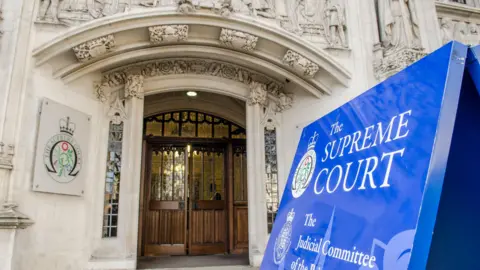 Getty Images
Getty ImagesJudges at the Supreme Court are considering how exactly women are defined in law, in a case which could have an impact on people’s rights across the country.
The case started out with a group of campaigning Scottish women challenging a bill passed at the Scottish Parliament.
But it has ended with the highest court in the land considering the proper interpretation of the Equality Act, a totemic anti-discrimination law which applies in Scotland, England and Wales.
The judges will spend some time considering their verdict - but what could it mean for trans people, women, other protected groups, and indeed politicians?
The issue
The question the court is considering is whether a person holding a gender recognition certificate which declares them to be a woman “for all purposes”, in the words of the Gender Recognition Act, should be included under the female sex for the purposes of the Equality Act.
The answer is unlikely to be a brief “yes” or “no”.
The five judges have heard hours of arguments and have hundreds of pages of written material to pore over.
The lawyers for each side set out a whole thicket of potential consequences and the court has been tasked with settling ambiguities in a range of areas.
The law can be a complex tapestry, and it is entirely possible that groups could lose protections under one statute, but would be able to fall back on others.
It's also possible that judges decide that definitions vary according to context in different parts of the law.
But they will have to be mindful to the fact that these rules have to be put into practice every day in society by non-lawyers - bosses in the workplace, hospital administrators, people running refuges, secretaries of clubs, and more - so it would be best to be clear about what is expected of them.
It would be foolish to predict how the judges will line up on any particular area, but here are some of the contested areas as suggested by the arguments we have heard in court.
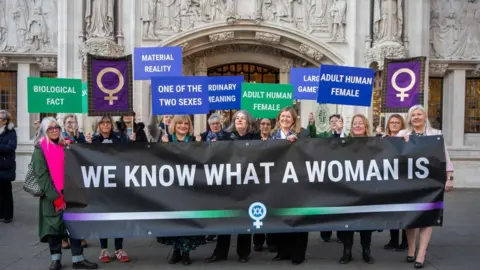 Getty Images
Getty ImagesIndividual rights
There are two broad sides to the case.
For Women Scotland, who say sex is an immutable biological fact; and the Scottish government, who say it can be changed with a gender recognition certificate.
Trans people see this case as challenging their very identity and fear that if the ruling goes to For Women Scotland, it would undermine their rights in their acquired gender.
They would still be entitled to protections under the Equality Act’s characteristic of “gender reassignment”, but not against discrimination on the grounds of sex.
So the ruling could determine whether a trans person would be able to pursue, for example, an equal pay claim as a woman.
For all the talk of the definition of “woman”, there was also a lot of focus on female-to-male transitioners - and in fairness there are just as many of them as there are male-to-female, according to census data.
Both sides in court seemed to agree that someone registered female at birth, who acquired a gender recognition certificate as a man, would lose their sex-based rights and access to spaces reserved for women.
While the government said this was in line with their choice, Aidan O’Neill - the KC representing For Women Scotland - argued that it amounted to protections being stripped from natal women, which he said was to “capitulate to the patriarchy”.
There was also a lot of focus on the idea of a “pregnant man” - the possibility of someone who gets a gender recognition certificate stating they are a man nonetheless becoming pregnant.
Would they still be entitled to pregnancy and maternity benefits enshrined in equalities law? Could they insist on being registered as the “father” of the child?
This is an extremely niche example which might ultimately only affect one person in tens of millions, at the most. Mr O’Neill had to produce case law which was “unfortunately only in French”.
But the judges in London may still have to come up with an answer to the question.
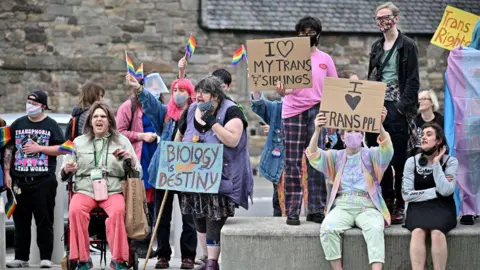 Getty Images
Getty ImagesGroup rights
Many of the more complex questions posed by the judges were about the rights of individuals.
Like the idea of someone registered male at birth, then later getting a GRC, saying they’re a woman, but who still appears or presents as a man.
Could they have been discriminated against as a woman if people, ignorant of the existence of the certificate, perceived them to be a man?
Ruth Crawford KC, representing the Scottish government, said she might need to draw up a flow chart over the lunch break to answer that one.
Her ultimate reply was that the government was chiefly focused on addressing group protections under the Equality Act, and that “individual scenarios” did not provide much assistance to the court on the core question of whether the GRA’s “for all purposes” definition applies to the 2010 Act.
A lot of the debate around the case when it comes to group protections is about single-sex spaces and services. Should trans people be allowed to use them, if they were not registered female at birth?
Things like women’s refuges, hospital wards and even prisons are able to exclude men on the basis of their sex due to the protections of the Equality Act.
In current practice, they are also often able to exclude trans people if they can show this is a “limited provision” which is “a proportionate means of achieving a legitimate aim”.
But the argument is that it could be much harder to exclude people with gender recognition certificates if the court rules they are protected as part of the female sex.
Indeed Mr O’Neill claimed this would make it impossible for a hospital to operate a women-only ward.
He said it would be “unworkable in practice” for hospital administrators to adjudicate - given they are not meant to ask to see a gender recognition certificate - who should and should not be admitted.
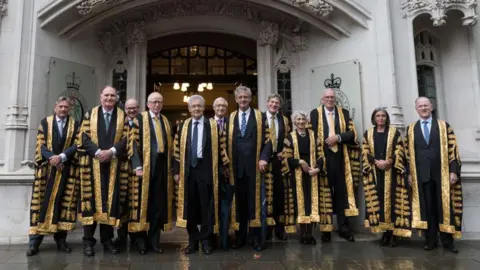 Getty Images
Getty ImagesA number of lesbian groups made a joint intervention in the case arguing that their right to form associations might be impacted.
As with single-sex spaces, the claim is that lesbian clubs would find it harder to exclude trans people without facing legal challenges if the Scottish government’s interpretation wins out.
Ruth Crawford’s response was that groups could still exclude people on other grounds - such as a philosophical belief that sex is immutable.
There was also discussion of a potential impact on sports - frequently a subject of controversy in the gender debate.
The Equality Act provides for sports events being segregated as a “gender-affected activity” where the “physical strength, stamina or physique of the average persons of one sex would put them at a disadvantage compared to average persons of the other sex”.
For Women Scotland queried what would happen if “sex” in this section came to include people with a gender recognition certificate?
The point made by Mr O’Neill wasn’t so much that sports federations could be open to challenge, but that it was clear that MPs were talking about biological sex when they drafted the 2010 Act.
But the Scottish government pointed out that the section of the act concerning sport also provides for excluding "a transsexual person as a competitor in a gender-affected activity" for the purposes of "fair competition" or "the safety of competitors".
So the question might be whether someone with a GRC would be viewed entirely under their acquired sex by the law, or if they would also remain under the characteristic of "gender reassignment" as a trans person.
Untying this kind of knot could be key to how the judges ultimately resolve this case.
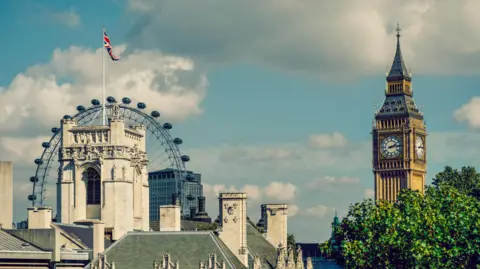 Getty Images
Getty ImagesPolitical questions
If the legal arguments seem dizzying, the case poses tricky political questions too.
Those start at Westminster, with the Equalities and Human Rights Commission intervening in the case to call for the Equality Act itself to be amended.
That was a Conservative policy during the general election - a favourite of the party’s now-leader Kemi Badenoch - so it may well come up in the Commons.
But would Sir Keir Starmer have the appetite to wade into the gender debate at the same time as the Commons is grappling with budget issues and topics like assisted dying?
There are also questions for the Scottish government, as the ultimate subject of this court case.
John Swinney has already been pressed by journalists about whether he thinks a man can get pregnant, and his blunt answer of “no” was a far cry from the nuanced response of his lawyers in court.
There was a spell where politicians were routinely pursued by the question of “what is a woman?” and the first minister will be keen not to be haunted by this new twist on it.
 PA Media
PA MediaIt seems likely that this case spells the end of the Scottish government's policy of self-identification for trans people.
It was already gathering dust on a shelf, after the reform bill passed on Nicola Sturgeon’s watch was blocked by ministers in London.
The official position of the government remains that it would like to see that bill become law - but frankly Mr Swinney’s administration would far rather keep out of the debate at this point, having seen the toll it took on his predecessor.
The first minister is certainly sympathetic to the arguments around gender reform, but he does not seem minded to lead the charge the way Ms Sturgeon did, particularly with a Holyrood election looming.
The court case may have shifted the case for self-ID too, if it clarifies exactly what a gender recognition certificate gets you.
The government’s position in court was that it amounts to a significant change of legal status with “far reaching consequences”, on a par with adoption.
Labour also had a manifesto pledge at the general election to “simplify and reform” the gender recognition process, removing “indignities”.
So UK ministers will also be watching this judgement closely in terms of how it pitches its future policies on gender reform.
